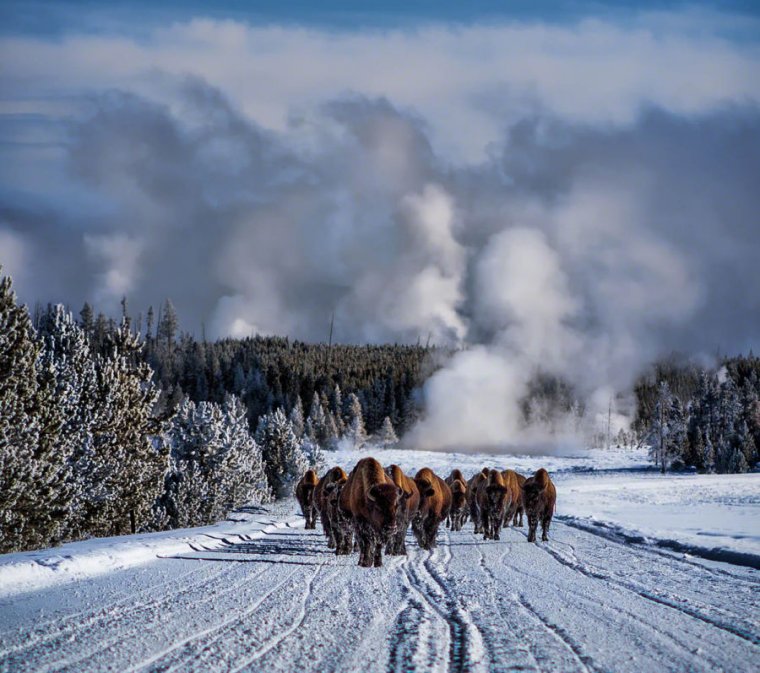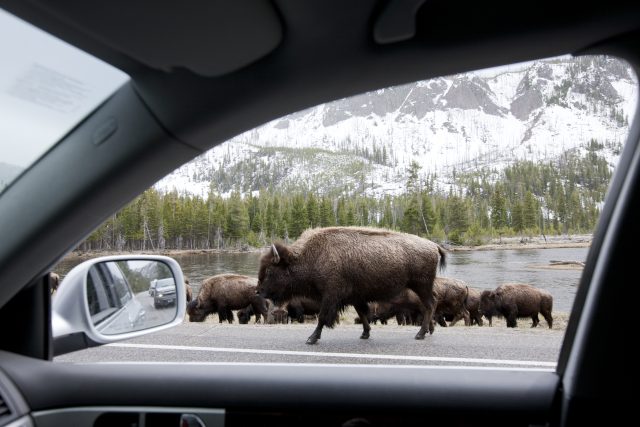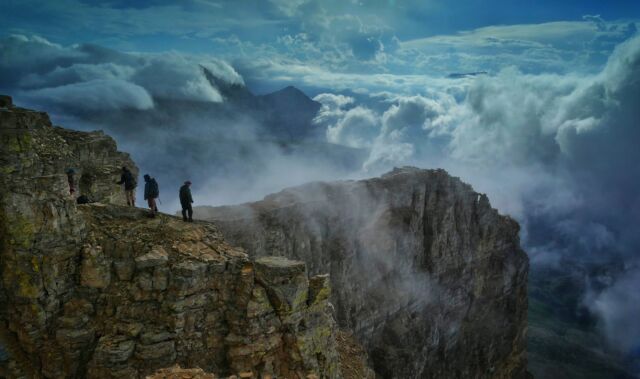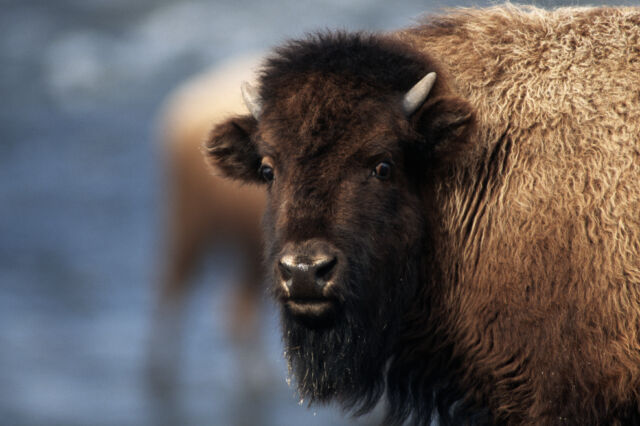
On a blustery October afternoon at the Wolfcrow Bison Ranch in southern Alberta, Canada, Dan Fox and his ranch hand, Man Blackplume, tried to wrestle fence panels into place despite a 60 mph wind. The next day was weaning day—and the fence needed to be rock solid so the bison calves could be separated from their mothers.
The two members of the Kainai First Nation, also known as the Blood Tribe, braced their bodies against the 12-foot-high fence panels so they could nail them to the posts, but the panels flapped in the wind like giant wooden flags. Across the pasture, 30 bison stood huddled together in the corner, unfazed by the commotion. They were part of the first bison herd to grace the Blood Reserve in 150 years, Fox says. The Kainai First Nation is one of four tribal groups within the Blackfoot Confederacy, which includes the Blackfeet Tribe in Montana.
Fox, 63, believes the animals may have helped extend his life. He experienced a cancer scare more than 20 years ago, and at the suggestion of a Blackfoot healer and naturopath, he changed his diet, replacing processed food with bison meat and other ancestral foods. His health improved, and today he says he feels better than ever. He is convinced that his family and his community will benefit, as he did, by having the buffalo back on the land and in their lives. (Bison bison is the scientific name for the animal, but buffalo is the word that most Indigenous people use.)
More importantly, he said, the bison began to teach him about his culture and what it means to be a Blackfoot. “The elders from back in the day predicted that the only way the Native people are going to start gaining ground again, their ways of life, is when the bison come back,” said Fox.
Research suggests there were 30 million to 60 million bison in North America in the 1500s. Four hundred years later, roughly 1,000 bison remained, a result of government policies that encouraged killing off the animals, largely to help defeat Indigenous inhabitants and force them onto reservations.
Fox and Blackplume’s ancestors not only relied on bison for sustenance, but depended on the Great Plains ecosystem that the bison coevolved with. Today, that ecosystem is among the most endangered in the world: according to recent estimates, about half of the North American Great Plains region has been converted to cropland, development, or other uses—with more conversion happening every year. When the land is converted for these uses, biodiversity declines and habitats are fragmented, making the land less resilient to global forces such as a changing climate.
In the early 2000s, Fox turned a cattle ranch into a bison ranch, part of a movement across the North American West to return bison to parts of their historic range for the collective well-being of various Indigenous nations in Canada and the United States. Several tribes have started their own herds, often on ground that had previously been used for cattle grazing. But the overarching vision for many Indigenous tribes is restoring free-ranging wild herds on tribal and public lands, and in the process, protecting and enhancing the remaining grasslands where the bison once roamed. But there are social and political challenges that have long stood in the way of bringing this vision to life.

Restored
There are now roughly 500,000 bison in North America, occupying less than 1 percent of their historical range. All but a few herds, such as the Yellowstone herd, Utah’s Henry Mountains herd, and the Banff National Park herd, live within the confines of fences. Even the so-called wild herds are not welcome outside parks and protected areas. This is largely because many livestock ranchers don’t want the competition for space and grass and are worried about the spread of brucellosis, a disease that can cause livestock, as well as deer, elk, and other wildlife, to miscarry their fetuses.
Outside of Yellowstone National Park, Native American tribes with treaty rights, including the Blackfeet Tribe in Montana and several other Northern Plains tribes, are allowed to hunt the animals as they leave the park, one way of managing the park’s bison population. Until recently, all the remaining bison were sent to slaughter. But Native American tribes and the Intertribal Buffalo Council (a federally chartered organization that represents tribal nations that want to restore bison to their reservations) are trying to change that. Instead of excess bison being sent to slaughter, they would like to see those animals restored to Native American reservations that want to start their own herds and supplement existing herds. A facility built by the Assiniboine and Sioux Tribes on the Fort Peck Reservation specifically for quarantining Yellowstone bison has been attempting to do just that. With the Fort Peck program, Yellowstone bison are trucked from the holding facility outside the park directly to the Fort Peck Reservation, where they are quarantined until they go through rigorous testing for brucellosis (which can take up to two years).
Many of the region’s Native American and non-native ranchers currently raise cattle, but over the past decade, research has pointed to bison as a more ecologically beneficial choice.
“There are small, nuanced differences that have great implications,” said Keith Aune, a conservation biologist and former bison specialist for the Wildlife Conservation Society, a non-governmental organization headquartered at the Bronx Zoo that works to protect wildlife and wild places. One of the biggest differences is that cattle tend to stick close to water sources and roam less widely than bison. Most breeds of cattle came from Europe, where they thrived in wetter and more confined spaces. “It depends on what you want to create,” said Aune. “If you want to create a monoculture with maximum pounds of grass,” then grazing “cattle would produce that outcome.”
“But if you’re looking for complex ecosystems with resilience and the ability to survive climate change and adapt to significant dynamics schemes that are playing out in our world,” he continues, “you would not graze cattle, and certainly not only cattle.”
Another advantage bison have over cattle is their ability to adjust their metabolism to suit environmental conditions. In winter, their range is the same as in summer, but they consume fewer calories, and they can survive on much less forage during a drought year, for example.
“Having bison back on the land is such a beautiful idea,” said Colleen Gustafson, a rancher in northwest Montana and member of the Blackfeet Nation Stock Growers Association. But, she added, “the people whose backyards it affects... are far different than those who live in town, or those whose livelihood does not depend on a rangeland and fences.”
Even so, bison are a potent symbol for tribes across the Northern Great Plains, and some of their members are tired of others telling them what is appropriate or allowed on their ancestral lands. "[Bison are] an animal that used to be so free,” said Helen Augare Carlson, a member of Montana’s Blackfeet Tribe. “Cows, they’re used to being fed. They’re going to wait to be fed. And that’s how we [Native Americans] got to be. We were penned for so long,” she said. After government policies drove bison to near-extinction, Augare Carlson said her people were forced to depend on the government for food. “We didn’t go out and hunt anymore. We waited for those rations, and that’s what killed us.”
Augare Carlson is referring specifically to the Starvation Winter of 1883 to 1884, when the buffalo had been almost entirely killed off, and the US government did not have adequate rations or supplies to feed the Blackfeet people through frigid winter storms on the northern plains of Montana. As a result, nearly 600 Blackfeet men, women, and children—more than a sixth of the tribe’s population—died of malnutrition.

Resilience
About 70 miles south of Fox’s ranch in Alberta, Augare Carlson recently sat in her home on the Blackfeet Reservation in Browning, Montana. Looking out a window across from a painted bison skull decorating her wall, she reflected on stories of her great-great-grandfather, who she said participated in his tribe’s last bison hunt in the late 1800s.
Then she recalled with a smile the day in 2016 when 88 bison arrived on the Blackfeet Reservation from Alberta’s Elk Island National Park, descendants of the same herds her great-great-grandfather had hunted.
“They’re family we haven’t seen,” she said. “This herd is for conservation and for life, and acknowledging that we all belong on the land. We both have reasons to take care of each other.”
The bison from Elk Island that today live on a former cattle ranch on the Blackfeet Reservation are part of a wider effort led in large part by the Blackfeet Tribe and Kainai Nation to restore a free-ranging herd to tribal land on the east side of Glacier National Park. This herd would be able to roam free on both tribal and public land and cross back and forth between the US and Canada. That, anyway, is the goal. For now, they live on tribal land and are managed by the Blackfeet Nation Buffalo Program, a branch of the tribe’s agriculture department that manages the herds owned by the tribe on the Blackfeet Reservation land.
Tribal members would be able to hunt the bison, which would keep their population in check and restore the traditional relationship between bison and hunter at the core of Blackfoot spirituality.
“When we say we’re closely related to the buffalo, it’s a keystone culturally,” said Leroy Little Bear, an elder in the Kainai First Nation and a professor emeritus of Native American studies at the University of Lethbridge. “It’s because our ceremonies, our songs, our stories—and of course sustenance is also related.”
The vision for this transboundary herd coalesced in 2014, when tribes from both sides of the border came together on Montana’s Blackfeet Reservation to sign the Buffalo Treaty. It was the first time in at least 150 years that the tribes had signed a treaty amongst themselves, said Little Bear. The result of decades-long efforts by Little Bear, the Blackfoot tribes, and the Wildlife Conservation Society, among others, the treaty recognizes the spiritual, cultural, and ecological importance of bison and affirms the desire to restore them first to reservations, and eventually, to larger tracts of public land.
“We’re looking at grasslands that have been severely damaged because of settler colonialism, where lands were taken from the Indigenous people and planted with European species, the buffalo removed, and fences put in,” said Cristina Eisenberg, an Indigenous ecologist who works with the Blackfeet Tribe and Kainai Nation in their efforts to establish a free-ranging herd.
“What buffalo do,” Eisenberg said, “is they create more resilient grasslands to climate change. They are able to continue to be beneficial to those grasslands even as the Earth gets hotter and hotter. Buffalo increase biodiversity. Biodiversity is insurance against climate change.” Not only that, but bison wallows—big open patches of dirt—bring structural diversity to the landscape, Eisenberg said, which increases resiliency.
Eisenberg, who has spent her career studying wolves and bison, applies a combination of Western science and traditional ecological knowledge, a field of environmental study based on ancient Indigenous knowledge. The field is particularly important for bison restoration efforts, she said, given that the Plains Indians—a term used to describe a number of Indigenous tribes that inhabit the Great Plains of the US and Canada—relied on the animal and its habitat for thousands of years.
“Bison would have historically been moving over that landscape depending on fire, depending on Native Americans, depending on predators, and depending on climate,” said Kyran Kunkel, a conservation biologist and affiliate professor at the University of Montana and a research associate with the Smithsonian Institute. Kunkel also collaborates with the American Prairie Reserve, a nonprofit group that aims to restore bison, remove fences, and piece together fragments of private and public land to restore the native prairie ecosystem.
“They were moving and creating a landscape that had great heterogeneity,” he added. “And so they were impacting grass, and vice versa, and that’s what led to the diverse ecosystems there—birds, small mammals, large mammals, and insects,” he said.
“The change we see today has occurred because of what we’ve done to other species directly—not just loss of bison but predator control and management with fencing, growing hay, and manipulating pasture lands,” said Kunkel.
The biggest impact that bison would have on prairie restoration, said Curtis Freese, a former biologist for the World Wildlife Fund and American Prairie Reserve, would be felt after the fences and manmade water sources were pulled out, and bison could interact with fire. Fire is a natural and essential part of the grassland ecosystem. Operating in concert with herbivore grazing, it speeds up decomposition that returns nutrients to the soil. Prior to European settlement, Indigenous tribes would intentionally set fire to the prairie, knowing that, once the grass burned, it would regenerate within several weeks, and then the bison would show up to eat the nutrient-rich grasses.
“Now you’ve got a functioning ecosystem,” said Freese, “where the dominant grazer can graze like they historically did to create the heterogeneous habitat that has been crucial to support the evolution of, in particular, grassland birds.”
Bison are also a valuable source of protein for carnivores in the wild as well as for the tribes, who also want to return bison meat to their diets. Their carcasses support swift fox, golden eagles, grizzly bears, wolves, all the way down to beetles and nematodes. “And then, of course, it’s like taking a bag of nitrogen fertilizer and dumping it on the ground,” said Freese.
Besides Native American efforts to restore bison, conservation groups throughout the United States have fought for a long time to return bison to parts of their native range. The American Bison Society, Boone and Crockett Club, and the New York Zoological Society have all been researching bison ecology and propagation. One of the most promising efforts is taking shape on historic bison habitat in central Montana, under the direction of the American Prairie Reserve. The nonprofit has a herd of around 810 bison on the land they have acquired thus far, but many cattle ranchers see the effort as a serious threat to their livelihoods and way of life that could further marginalize their businesses.

Conservation through collaboration
In Glacier County, home of the Blackfeet Reservation, ranching drives the local economy. Many ranchers—including some Native Americans—view bison as a threat; as competition for scarce resources, such as grass and water; and as potential carriers of diseases deadly to cattle. Yet other ranchers are trying to regenerate the land through changing cattle grazing methods, which in some cases includes managing cattle in ways that mimic how bison historically grazed and moved across the land.
Book St. Goddard, a Blackfeet tribal member, fifth-generation rancher, and vice chair of the Blackfeet Nation Stock Growers Association, takes a firm stance on the bison issue. “They’re a pain in the ass to the people who ranch right by them,” he said. “They wipe out fences,” he added, forcing ranchers like him to bear the cost of putting them back up.
St. Goddard also questions how his tribe benefits from the herd and worries the money spent maintaining the herd may not be recouped. He said the tribe planned to meet with the Stock Growers Association to discuss the ranchers’ concerns, but in the last year and a half, no such meeting has happened. “I think there’s got to be transparency. They need to tell people what they are planning,” St. Goddard said.
Kristen Kipp Preble, a Blackfeet rancher and member of the Blackfeet Nation Stock Growers Association, sees bison as a positive influence for her culture. But like St. Goddard, she also acknowledges the struggle for land and natural resources for those in her community who ranch in one of the coldest landscapes in the West. She worries that introducing free-roaming bison herds could greatly impact ranchers’ livelihoods.
The risk that bison will spread brucellosis—the disease that causes miscarriages in livestock and which can be transmitted between the two species—also alarms many ranchers and fuels their resistance to the idea of free-roaming bison. Fencing buffalo pastures could ease some of these tensions, but Kipp Preble is also concerned about how those fences might affect the migration paths of other wildlife, such as elk, which many tribal members harvest to feed their families for an entire year.
As a result of all these pressures, Kipp Preble said, bison reintroduction “needs to be done in a way that everyone is taken care of.” That would mean better fences, greater clarity by the Blackfeet Nation Buffalo Program regarding their goals and intentions, and ensuring that cattle producers are not displaced by the bison herd.
On the Blood Reserve, Dan Fox, the Kainai bison rancher, holds a ceremony every October in which three bison are harvested to feed elders and families in the community who are in need. Elders from the community come and give their blessings and teach younger members how to harvest and butcher the meat, turning the bison into sustenance and using all parts of the animal for other ceremonial and cultural purposes.
“If you know where you come from and have that connection, it makes you proud,” said Amanda Weaselfat, a Kainai woman who participates in Fox’s harvests each year. “To think there used to be so many of them here and they used to sustain our lives. They were our life force. For me that’s a very humbling and powerful thing.”
“Bison conservation will not succeed unless it is in collaboration with Native people and incorporates traditional ecological knowledge,” said Eisenberg.
“That empowers those communities and it honors them and helps heal some of the damage that has been done—the genocide and all of that.”
As Fox put it toward the end of weaning day, standing in the corral eyeing the calves that had been separated from their mothers, “Everything now—the restoration of bison—when you come right down to it, it’s the spiritual end of the bison that’s making a strong impact.”
In February, Fox and members of the Kainai Nation finally realized their goal of returning a tribally owned herd of bison to the Blood Reserve. The animals came from Elk Island National Park, the same genetic stock that live on the Blackfeet Reservation.
“These animals were brought back to restore a keystone part of our environment,” said Fox. “It will, in the long run, be a win-win for both people and the environment here on the Reserve.”
Louise Johns is a documentary photographer and journalist based in Montana. Her work has appeared in a variety of outlets including The New York Times, The Washington Post, High Country News, and National Geographic.
"back" - Google News
June 06, 2021 at 07:30PM
https://ift.tt/3zaaP8G
When the bison come back, will the ecosystem follow? - Ars Technica
"back" - Google News
https://ift.tt/2QNOfxc
Shoes Man Tutorial
Pos News Update
Meme Update
Korean Entertainment News
Japan News Update
Bagikan Berita Ini















0 Response to "When the bison come back, will the ecosystem follow? - Ars Technica"
Post a Comment